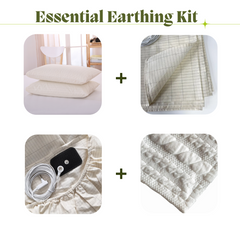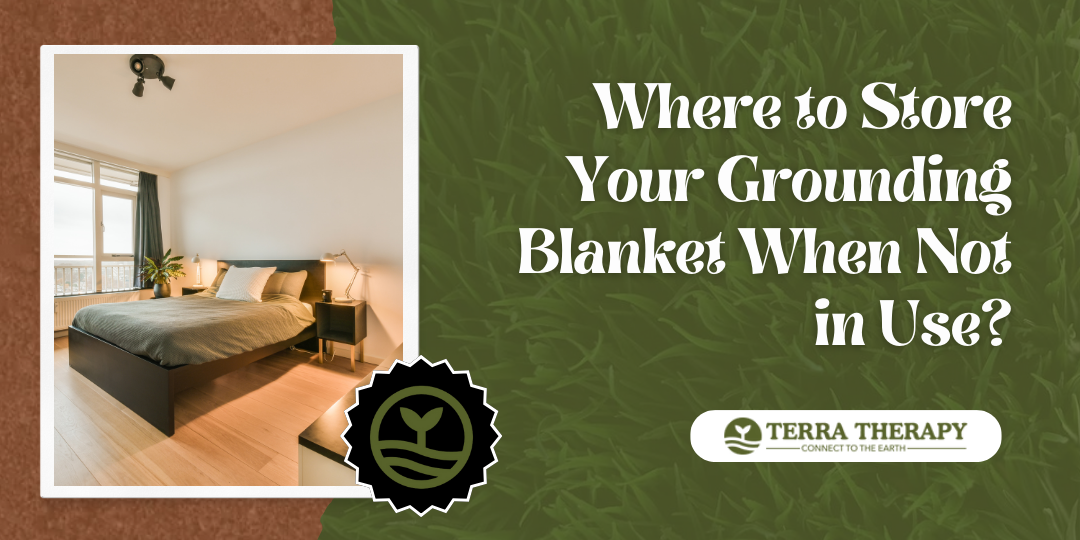Have you ever wondered where to tuck away your grounding blanket when it's not enveloping you in its calming embrace? Storing your grounding blanket properly is crucial for maintaining its effectiveness and longevity, yet it must often be noticed.
With the right storage strategy, you can preserve the quality of your grounding blanket and ensure it's always ready to provide comfort and connectivity when you need it most. Let's dive into simple yet effective ways to store your grounding blanket, keeping it in prime condition for every use, using good quality tools, and ensuring easy access to the plug.
Key Takeaways
- Dry and Cool Environment: Store your grounding blanket in a dry, cool place to maintain its integrity and prolong its lifespan.
- Avoid Direct Sunlight: Keep the blanket away from direct sunlight and excessive heat to prevent damage to the conductive materials.
- Proper Folding: Fold the blanket neatly without sharp creases to avoid damaging the conductive fibers.
Why Proper Storage of Your Grounding Blanket is Essential?
Storing your grounding or earthing blanket correctly ensures its longevity and effectiveness. These blankets, tools that ground you by connecting you to the earth's natural electric charge can help improve sleep quality, reduce inflammation, and induce changes in your body. However, improper storage can damage the conductive fibers, rendering the blanket less effective.
It's crucial to keep the blanket dry and away from direct sunlight. Moisture can corrode the metallic threads woven into the fabric, while UV rays from the sun can break down the material over time. They were folding it neatly when not in use, preventing creases that could strain and eventually snap the delicate conductive threads.
Avoid storing your grounding blanket in plastic bags or containers that trap moisture. Instead, opt for a breathable cotton bag that allows air circulation. This precaution prevents mold growth, which not only damages the blanket but also poses health risks.
Moreover, keep sharp objects from your earthing blanket during storage. Snags or tears can interrupt its grounding capabilities by breaking the continuity of the conductive threads. Regular checks for damage will help maintain its integrity and functionality.
Where to Keep Your Grounding Blanket When It's Not Being Used?
Storing your grounding blankets correctly is crucial for maintaining its effectiveness and longevity. The ideal storage place is in a cool, dry area away from direct sunlight. This prevents the conductive materials from degrading over time.
A linen closet or a dedicated bedding drawer offers the perfect environment. These spaces typically maintain a consistent temperature and humidity level, which benefits the grounding blanket. Ensure the blanket is folded neatly to avoid unnecessary creases or damage to the conductive threads.
Under-bed storage containers can be an excellent alternative for those living in smaller spaces. They protect from dust and are easily accessible. However, using a breathable container is essential to prevent any moisture buildup.
If you travel frequently, consider investing in a travel bag designed explicitly for grounding blankets. These bags protect your blanket on the go and ensure you can continue to enjoy the benefits of grounding no matter where you are.
Remember, improper storage can reduce your grounding blanket's efficacy over time. Choosing an appropriate storage solution can help extend its lifespan and maximize its health benefits.
How to Store Your Grounding Blanket to Prolong Its Lifespan?
Proper storage is crucial for maintaining the effectiveness and longevity of your grounding blanket benefits. After deciding on a suitable location, as discussed previously, the next step is to focus on how to store it correctly. This involves both short-term and long-term considerations.
For short-term storage, ensure the blanket is dry and free from debris or dirt. Fold it gently without pressing too hard to avoid damaging the conductive fibers. Avoid storing it in plastic bags or containers that can trap moisture, leading to mildew or mold. Instead, opt for a breathable cotton bag or a dedicated shelf where air circulation can prevent dampness.
Long-term storage requires more care. If you don't use your grounding blanket for an extended period, clean it according to the manufacturer's instructions. This often means washing it with mild detergent and letting it air dry completely. Once clean and dry, fold it loosely to prevent any permanent creases in the material that could affect its conductivity.
Store it in a cool, dry place away from direct sunlight, which can degrade the materials over time.
What Are the Best Storage Solutions for Your Grounding Blanket?
Finding the proper storage solutions for your best grounding blanket is crucial. It ensures the blanket's longevity and maintains its effectiveness. Here, we explore options that cater to different needs and spaces.
Breathable cotton bags are a top choice. They allow air circulation, preventing moisture buildup, which can damage the grounding capabilities. Opt for ones with a drawstring closure for easy access.
Vacuum-sealed bags offer an alternative for those with limited space. Removing air reduces the blanket's size, making it easier to store in tight spots. However, ensure it's not stored compressed for long periods to avoid fiber damage.
A dedicated shelf or drawer in a cool, dry place works best for daily users. This method keeps the blanket within reach while protecting it from direct sunlight and dust.
Lastly, consider using a portable container if you travel often with your grounding blanket. Hard-shell cases protect against physical damage, while soft padded bags cushion against impacts.
Each solution has its merits depending on your lifestyle and storage capacity. Whether you opt for breathable bags or vacuum-sealed options, maintaining proper storage conditions, as mentioned in "How to Store Your Grounding Blanket to Prolong Its Lifespan?" is critical. Regular checks for cleanliness and damage can further extend your best grounding blanket's life.
Why Protect Your Grounding Blanket from Dust and Debris During Storage?
Protecting your grounding blanket from dust and debris during storage is crucial for maintaining its effectiveness. Grounding blanket for bed are designed to connect you to the earth's electrons, which can be hindered by dirt accumulation. Dust particles can create a barrier between the fabric and your skin, reducing conductivity.
Moreover, debris can cause physical damage to the blanket. Sharp particles might tear or fray the material, compromising its structure. This damage affects the blanket's performance and shortens its lifespan. Keeping it clean ensures that it remains in optimal condition for longer.
Storing your grounding blanket properly follows naturally after finding the best storage solutions. It's not just about where you store it but how you protect it while stored. This is especially important for bed use of a grounding blanket because it directly impacts your sleep quality and the health benefits of grounding.
To safeguard your investment:
- Always fold or roll the blanket loosely to avoid stress on the fabric.
- Place it in a breathable storage bag to prevent moisture buildup, which can lead to mold or mildew.
- Keep it in a cool, dry place away from direct sunlight to preserve the integrity of its conductive elements.
Where Can You Find Storage Containers Suitable for Grounding Blankets?
Finding the proper storage solution for a grounding blanket ensures longevity and effectiveness. Specialized containers designed for this purpose are available but not commonly found in regular stores. Online marketplaces stand out as the primary source. They offer various options for different sizes and types of grounding blankets.
Manufacturers of grounding blankets often provide custom storage solutions. These protect the blankets from dust, debris, and moisture. Checking with the manufacturer can lead to finding a container that fits perfectly in size and material.
Outdoor equipment stores are another unexpected source. They carry containers that, while not made for grounding blankets specifically, meet the necessary criteria for safe storage. Look for waterproof and dust-proof options here.
For those preferring a DIY approach, constructing a storage container from durable materials like plastic or metal is feasible. Ensure it seals tightly to keep out unwanted elements.
How to Properly Fold Your Grounding Blanket for Storage?
Proper folding and storage of your earthing blanket can extend its lifespan and maintain its effectiveness. After selecting a suitable container, as discussed in the previous section, follow these steps to fold your grounding blanket correctly.
First, lay the blanket flat on a clean surface. Make sure there are no wrinkles or folds. Start by folding the blanket in half lengthwise. Then, fold it in half again in the same direction. You should now have a long, narrow strip.
Next, fold the strip in small sections, about one foot at a time, pressing down gently to remove any air trapped between the folds. Continue this process until a compact square or rectangle fits comfortably within your chosen storage container.
It's crucial to store the blanket in a cool, dry place away from direct sunlight or heat sources. These conditions can degrade the conductive materials within the earthing blanket over time.
For those who frequently travel or want to keep their grounding blankets pristine, consider using vacuum-seal bags designed for clothing. This method saves space and protects the blanket from moisture and dust.
What Are the Benefits of Storing Your Grounding Blanket in a Cool, Dry Place?
After mastering the art of adequately folding your grounding blankets, it's crucial to store it correctly. Keeping it in a cool, dry place offers several benefits that extend its lifespan and efficacy. Firstly, moisture is a grounding blanket's nemesis. It can lead to mildew and mold growth, damaging the fabric and reducing its grounding capabilities.
A dry environment prevents these issues, ensuring your best grounding blanket remains effective.
Moreover, exposure to excessive heat can degrade the conductive materials within grounding blankets. These materials are vital for its operation, as they connect you to the earth's electrons. Storing your blanket in a cool place protects these materials from breakdown. This preservation is critical to maintaining the blanket's ability to reduce inflammation and improve sleep.
Proper storage shields your grounding blanket from dust and other contaminants accumulating on its surface. Such pollutants can hinder its conductivity and overall performance. A clean storage area ensures that every time you use your blanket, you're getting the maximum benefit without interference.
Lastly, considering how integral these blankets can become for those who rely on them for better sleep and reduced stress, keeping them in optimal condition is essential. It means less frequent replacements and sustained health benefits.
Conclusion
Proper storage of your best rounding blanket is not just a matter of convenience; it's a crucial step in ensuring its longevity and effectiveness. Following the guidance provided protect your investment from dust, debris, and environmental factors that can degrade its quality.
Keeping your grounding blanket in a cool, dry place, properly folded, and inside suitable storage containers will maintain its grounding capabilities, ensuring you reap the full benefits of its use. Your health and well-being are paramount, and taking these steps guarantees that your grounding blanket remains an invaluable asset in your wellness toolkit.
Now's the time to take action. Review your current storage solutions and see if they align with the best practices outlined. If not, consider making the necessary adjustments. Remember, a little effort in storing your grounding blanket correctly pays off with lasting benefits. Start today and ensure your grounding blanket continues to serve you well for years.





